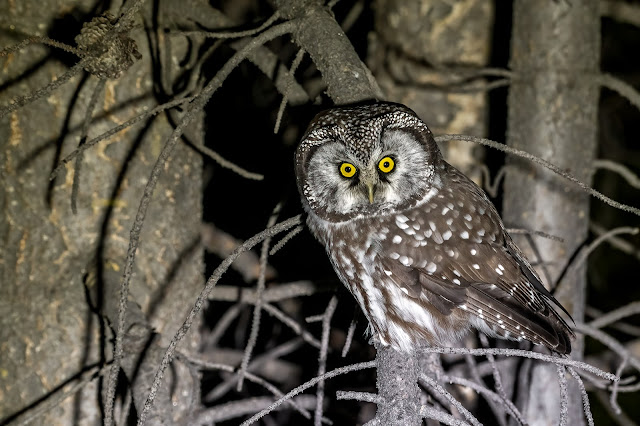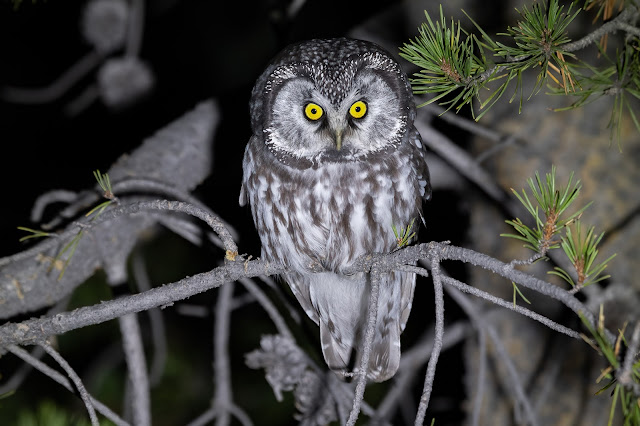 |
| Boreal Owl in Utah's Uinta Mountains |
After surprising success with finding three Boreal Owls during my first attempt to locate them in Utah's Uinta Mountains in October of 2020, I began to wonder how common they might be in the high-elevation forests of Utah. I had read and studied numerous articles about Boreal Owls and noticed that Colorado and Idaho populations were often discussed. Utah was noticeably missing from many of the articles I read. The Uinta Mountains of Utah seemed like a natural bridge between the Colorado and Idaho populations, but I was having a hard time finding studies that had been done on Boreal Owls in Utah. I wanted to know more, so I began to consider how to go about a personal endeavor to learn more.
The preferred Boreal Owl habitat in Utah seems to be above 9000' and is often inaccessible to vehicular traffic due to heavy snowfall between November and late spring. Male Boreal Owls are most vocal when establishing their breeding territories and courting their mates, so I decided that I'd try finding them again as soon as the roads opened the following spring/summer. Unfortunately, I failed to locate Boreal Owls when I drove up to proper habitat the following June. I didn't hear a single sound from any species of owl that night despite playing some recordings of several types of vocalizations. A second summer trip proved unsuccessful in terms of locating birds, but it taught me a few things about conditions that may be unappealing to Boreal Owls. After doing a little more research, especially making use of my subscription to The Cornell Lab of Ornithology's Birds of the World, I learned that males generally stop singing on their territories once they have a female using a cavity for nesting. Except for minimal contact calls and some vocalizations when the male is delivering prey to an incubating or brooding female, the birds are quiet. That makes them very difficult to locate in sprawling dense coniferous forests in the Uinta Mountains.
A third trip made during September of 2021 proved successful. It seemed to confirm that birds are more prone to vocalizing in response to calls during the fall. As was the case the previous fall, I found multiple birds in close proximity to one another. That is when I began to wonder if I was finding family groups that were dispersing and if most of the vocal birds might be hatch-year birds and parents communicating with one another. The plumage always appeared adult-like, but I suspect that hatch-year birds are coming into their adult plumage by that time of the year if they hatched five or six months earlier.
After locating birds two falls in a row (2020 and 2021) and reporting them on eBird, the location where I found my first three was becoming more widely known and visited more frequently by local and out-of-state birders. That's when I decided to develop a plan to plot four new locations that looked promising based on elevation, tree mix, and barriers to human traffic. I then shared the plan with a couple of friends, Terry Reid and James Loveless, who had also been studying the species locally. They were excited to work together to learn more. We wanted to prove to ourselves that the lack of Boreal Owl observations in Utah stemmed from more of an access challenge than a lack of their presence. The three of us wanted to prove that Boreal Owls were more common in Utah than birders and others realized. Perhaps our results and documentation would lead to having the species removed from the list of rare birds that get reviewed and validated by the Utah Bird Records Committee.
Terry was an eager driver with no fear of putting a fair amount of wear and tear on his tires and suspension as we traversed very rugged terrain. The "Rocky Mountain pinstripes", courtesy of the many tree branches extending over the unmanaged rough roads, seemed to be part of the price to make exciting discoveries. James is the one who inspired me to begin my Boreal Owl endeavors when he located and photographed a Boreal Owl a few months before I found my first three in the Uinta Mountains. We became the three Boreal Owl amigos and logged hundreds of miles, many hours, and late nights to create bonding conversations and experiences. It turned out that we found Boreal Owls in each of the four new locations that I had mapped. We found them on the north slope, two locations west of Mirror Lake Highway (one on the northern end and the other on the southern end), and a spot above Soapstone Campground. We found them along Murdock Basin again the same fall.
We observed over twenty different Boreal Owls in the fall of 2022. While we aren't biologists, we did our best to document location, time, weather conditions, moon phases, and counts of individual birds. We photographed nearly every bird we found and in most cases we found two or more birds in each location. Whenever we located birds, we would drive at least a half mile or more before attempting to check for the presences of additional individuals.
We realize that populations can be cyclical and that we were primarily in the western portion of the Uinta Mountains, so we have plans to investigate other locations in 2023.
Below are some images of a handful of the more-than-twenty individuals we observed during the fall of 2022. All of our encounters and details are recorded in eBird checklists.
More to come.
 |
| Boreal Owl in Utah's Uinta Mountains |
 |
| Boreal Owl in Utah's Uinta Mountains |
 |
| Boreal Owl in Utah's Uinta Mountains |
 |
| Boreal Owl in Utah's Uinta Mountains |
 |
| Boreal Owl in Utah's Uinta Mountains |
 |
| Boreal Owl in Utah's Uinta Mountains |









